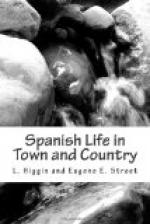Spanish women are great dressers, and the costumes seen at the race-meetings at the Hippodrome, and in the Parque, are elaborately French, and sometimes startling. The upper middle class go to Santander, Biarritz, or one of the other fashionable watering-places, and it is said of the ladies that they only stop as many days as they can sport new costumes. If they go for a fortnight they must have fifteen absolutely new dresses, as they would never think of putting one on a second time. They take with them immense trunks, such as we generally associate with American travellers; these are called mundos (worlds)—a name which one feels certain was given by the suffering man who is expected to look after them.
There are many little details in Spanish life, even of the upper classes, which strike one as odd. One, for instance, is the perfect sangfroid with which they pick their teeth in public; but so little is this considered, as with us, a breach of good manners, that the dinner-tables are supplied with dainty little ornaments filled with tooth-picks, and these are handed round to the guests by the waiters towards the close of the meal. Nor is it an unknown thing for a Spanish lady to spit. I have seen it done out of a carriage window in the fashionable drive without any hesitation. At the same time, as one of the great charms of a Spanish woman is the total absence in her of anything savouring of affectation, one would far sooner overlook customs that are unknown in polite society with us than have them lose their own characteristics in an attempt to imitate the social peculiarities of other nations that have incorporated the ominous word “snob” in their vocabularies. It has no equivalent in the language of Castile, and it is to be hoped will never be borrowed. Nevertheless, a recent Spanish writer laments the fact that in the race for “el high life” his fellow-countrywomen “are not ashamed to drink whisky!” We have yet to learn that whisky-drinking among women is an element of good style in any class of English society. The idea that Spanish ladies were in the habit of smoking in past times is a mistake. If they do so now it is an instance of the race for “el high life,” of which the writer quoted above complains.




